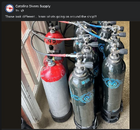I watched the entire video

Dan for sure get paid on this. He cannot stop saying how good this setup is. And we know in life, espcially in scuba, nothing is that one sided.
The first thing I don't get is the size of the tank. Typical AL80 is a 11L tank. 18lb wing (consider smaller for tropical diving) is about 8L in volume. If this tank is the same size of AL80, and allocated 18lb worth of air space for lift, then the left over la 5L for breathing gas. At 3000psi, this is about 50CF of breathing gas in it, give or take. It will be a short dive. They said they often dive this to 150ft for, with a 50CF of air??
Must of the problem discussed in this video is a weighting problem. Tropical diver carry too much weight, so when BC fail, they sink like rock. Or they carry too big of wing, when inflator get stuck they ascent uncontrollably. With this Avelo, it is kind of force the diver to be weighted correctly, otherwise, diver won't even be able to float head out of water. But then if the diver is weighted properly, then BC failure isn't an problem either.




